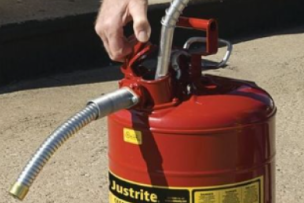COMBINATION LASERS:
Combination lasers project both lines and spots simultaneously or independently. These lasers are great for professionals who complete a wide range of projects as they allow the user to switch between lines, spots, or both depending on the job at hand. Electricians and plumbers will find these lasers to be extremely helpful for countless applications such as installing lighting, outlets, running wires, and pipes.
DEWALT offers combination lasers in both red and green variations. Our newest combination lasers are offered in the 12V MAX* system and include 2-spot cross and 5-spot cross models. A suggested sku is their 12V MAX* 5 Spot + Cross Line Green Laser. This laser includes an integrated bracket to easily mount onto metal surfaces. It also offers a 165-foot range with a detector for the line, and a 150-foot range for the spot.
ROTARY LASERS:
Rotary lasers are used to kick off nearly every professional construction job. Their applications range from grade work (digging foundations), to layout and masonry. Both dual-slope and single-slope rotary lasers are used to continue a desired pitch across a large area. The desired pitch might be level for finding grade or when using a reference line. Dual-slope means that the line will move along both the X axis and Y axis. X mode is used often to “walk” the line in vertical mode for aligning metal track. Y is used to angle the line in horizontal mode for setting slope or setting pitch on a driveway.
From an accuracy standpoint, DEWALT offers a rotary laser that works up to 2,200 feet with an accuracy of 1/16 inch at 100 feet. This laser is the 20V MAX* Tool Connect™ Green Tough Rotary Laser (DW080LGS). This rotary laser is extremely durable with the ability to withstand up to a 6-foot drop, and an IP67 rating for water and dust protection. Connect it to the Tool Connect™ app via Bluetooth® technology for features including tool tracking, bump notifications, fall and drop indications, and changes in slope and line detection.
LINE AND ROTARY DETECTORS:
There are 2 types of detectors used in the construction industry: Line and Rotary. Since line lasers and rotary lasers work on different wavelengths, they require specific detectors. The detectors are also color-specific. This means a red line laser requires a red line detector. For both rotary lasers and line lasers, detectors are not a requirement, but they do come in handy when the beam is no longer visible. For DEWALT, the standard visibility range on their line laser levels is 50 to 100 feet. While using the detector that range is extended out to 165 feet. Rotary laser detectors allow for detection up to 2,200 feet with the DW079 and DW080 series.
GRADE RODS:
Grade rods are used in conjunction with rotary lasers for digging or leveling earth. You must move the detector up or down on the grade rod while the rotary is spinning until you identify the laser line. When that laser line is found you have then established “grade” or level. If you are looking to dig a hole that is 3 inches deep, for example, you would move the detector 3 inches up the grade rod. After you dig 3 inches down and place the grade rod in the hole, you should hear a beep and read that the laser is hitting the detector. This is verification that you have dug the 3 inches deep.
BOTTOM LINE
As you can see, DEWALT offers a robust line of lasers including spot, line, combination, and rotary, as well as laser accessories to go with them. With the professional in mind, they will continue to evolve and innovate these products to accommodate needs on the jobsite. Keep checking back to see what new products DEWALT has to offer.
Previously Featured on DeWalt's Featured Articles.




Talk to Us!
Leave a reply
Your email address will not be published. Required fields are marked *